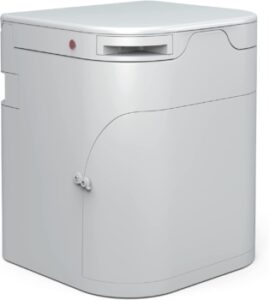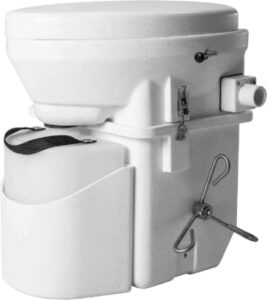The Reverend Henry Moule of Fordington invented the first composting toilet in the 1980s, and he discovered that dry earth and human waste together produce clean compost in a few weeks. Compost toilets not only reduce water use but also recycle valuable plant nutrients. Although the compost toile designs have been evolving since their discovery, the idea of composting is the same. Read this guide further to understand the working of these sustainable toilets.
What is Compost Toilet?
A composting toilet is an alternative to traditional toilets. It works by mixing human waste with sawdust or peat moss. The odors are eliminated through an anaerobic process.
Human waste is recycled through decomposition and evaporation. Human waste is 90% water, which evaporates through a venting system. The rest is decomposed to make natural fertilizer.
A compost toilet separates the liquid and solid waste through its venting system.

Types of Compost Toilets
Compost toilets are of various kinds; some have fans while others don’t. Some need power to operate while others are totally off-gird. Compost toilets have two basic types: slow compost toilets and active compost toilets.
Slow Compost Toilets
Slow compost toilets are also called moldering privy, and they are used infrequently or usually present at remote locations. The construction of these toilets is very simple as there is a box at the bottom and a seat on its top. Below the box, a contained compost system is installed that slowly decomposes the human waste. This system doesn’t help in pathogen elimination as it takes time to decompose human waste.
Slow compost toilets are best to use in remote locations as they save money and time and don’t leave behind the waste, so underground water is not contaminated.
Active Compost Toilets
Active toilets usually have fans that incorporate the oxygen into the system, so the composting process speeds up. Besides this, some active compost toilets have a heater to maintain a certain temperature that helps quickly degrade human waste. For the fan and heater to work, there should also be an electric source. You need to add some absorbent material to incorporate the oxygen into the system and also add carbon to it.
You can install these toilets where the use frequency is higher than the slow composting toilets. If you carefully balance all the elements and materials, you will get pathogen-free compost from active compost toilets.

How Does Compost Toilet Work?
In compost toilets, liquids are separated from solids. Liquids are collected in a bottle and can be disposed of when the bottle or container is full. The solid waste is collected in a separate systemized container. The solid waste is combined with carbon-rich materials, including peat moss and coconut husk. To start the composting process, you need to turn a mechanical crank to mix the elements thoroughly. Bacteria and other microbes will break down the organic matter under optimum moisture and temperature conditions. In the end, you will get a nutrient-rich fertilizer. Overall, the composting toilet must perfume the following functions.
- Compost the human waste and toilet paper speedily and eliminate the odor
- Ensure that the compost is safe and easy to handle
- Evaporate the liquid from the waste
Misconception about Composting Toilets
Although composting toilets are not a new idea, many people still don’t know what composting toilets are. They have various misconceptions about these toilets, which are:
Unsanitary
People might think that composting toilets are unhygienic. That’s not true, as the composting process eliminates harmful bacteria. Liquid and solid wastes are kept separated, and solid waste is dried carefully to eliminate maximum germs.
Odor
Most people think that compost toilets smell. The reality is that compost toilets smell less than traditional toilets due to their construction. Liquids and solids are separated, and carbon-rich material is mixed with the waste. A venting system is also installed and helps eliminate the odor.
Toilet paper
Contrary to popular belief, you can use toilet paper if you are using a compost toilet. Toilet paper is a compostable item and is frequently added to compost piles.

Benefits of Compost Toilets
Composting toilet is energy-efficient, reduces human waste, and converts it into valuable fertilizers. Here are the few incredible benefits that compost toilets offer.
Water-Saving
A federal requirement mandates that toilets only use 1.6 gallons of water per flush. It makes 2336 gallons of water if a toilet is flushed 5 times. Installing a compost toilet will save an immense amount of water.
Little Installation Cost
Traditional toilets require many installation elements, including pipes and hoses. They also require bending and maintenance costs. On the contrary, compost toilets are cost-effective, and you don’t have to pay much for their maintenance. Once you have installed your compost toilet, you just need a bottle of cleaning enzymes occasionally, and you are good to go.
Free Compost
The most notable benefit of compost toilets is that they convert human waste into nutrient-rich fertilizer or compost. You will get free compost through decomposition as you don’t have to spend your money on a specialized compost setup.
DIY Compost Toilet
You can also make a DIY compost toilet, but it requires high-level plumbing and electric skills. Here is a video tutorial to help you make a compost toilet for your RV or trailer.
Frequently Asked Questions
What do insects in a compost toilet indicate?
If your compost toilet is working, it’s unlikely to have an insect problem. If your compost toilet is unbalanced, you might face insect issues. So, if you find insects in your compost toilet, there must be a fault in your compost system.
Do composting toilets smell unpleasant?
It’s a misconception about compost toilets that they smell bad. In a compost toilet, liquid and solid wastes are separated, and an air vent is installed. Overall, a composting toilet is designed so that it doesn’t smell bad as all the waste material dries out immediately and decomposes.
How often do you have to empty your composting toilet?
It depends on how frequently and how many people use the toilet. Moreover, some toilets have more capacity. So, the cleaning and emptying frequency varies.
What is the average cost of a compost toilet?
The cost varies from $900 to $ 1500. We know this is a lot for many homeowners, especially if you have to install 3-4 toilets. However, the benefits are also great. You’ll save on septic tank costs, plumbing, and water bills (until you don’t install a traditional toilet).
Are there any drawbacks to using compost toilets?
Yes. Compost toilets have some disadvantages as well. You’ll have to remove the waste manually. It is not always pleasing to use a compost toilet. Moreover, some smaller units have a limited capacity to handle waste, requiring frequent emptying. They work on electricity and thus increase the bills. Further, improper installation can lead to odors and unprocessed material.

Leave a Reply